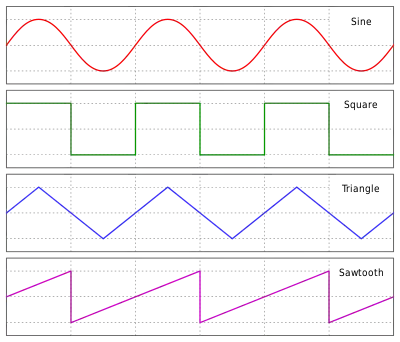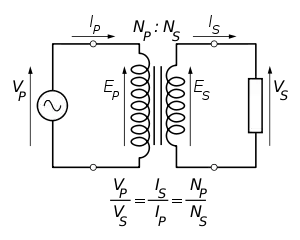Alternatif akım
Alternatif akım (AA veya AC İngilizce: Alternating current), genliği ve yönü periyodik olarak değişen elektriksel akımdır. En çok kullanılan dalga türü sinüs dalgasıdır. Farklı uygulamalarda üçgen ve kare gibi değişik dalga biçimleri de kullanılmaktadır. Bütün dalgalar birbirlerine elektronik devreler aracılığı ile çevrilebilir. Devrede kondansatör, diyotlar, röle ler ile bu çevrim yapılabilir.
| Elektromanyetizma |
|---|
 |
|
|
Elektrodinamik |

AA güç genellikle sanayi ve konutlarda kullanılır. Santrallerde üretilen enerjinin sevkinde de AA kullanılmaktadır. Deniz altına yapılan enerji nakil hatlarında üretilen AA elektrik, dalga yapısında bozulmalara sebep verilmemesi için DC'ye dönüştürülerek taşınmaktadır. HVDC ismi verilen uygulama ile okyanus ya da deniz altından nakil hatları işlenebilmektedir.
Tarihçe

İzolasyonlu kablolar arasındaki alternatif akım etkisini pratikte ilk dizayn eden William Stanley'dir. İndüksiyon bobini adını verdiği ve transformatörün atası olan sistemle alternatif akımla ilgili çalışmalarına başlamıştır. Bugün kullanılan haliyle alternatif akım ilk olarak Nikola Tesla tarafından 1886 yılında laboratuvar ortamında üretilmeye başlanmıştır. Tesla daha sonra patentini George Westinghouse'a satmıştır. O yıllarda Lucien Gaulard, John Dixon Gibbs, Carl Wilhelm Siemens ve diğer bazı bilim adamlarıda, bu alanda çalışmalar yapmışlardır.
Endüstriyel amaçlı üç faz (İngilizce: Three-phase) AC elektrik akımı üreten ilk santral ise, 1893 yılında Almirian Decker tarafından Kaliforniya'daki Mill Creek hidroelektrik santralinde kurulmuştur. Decker'in tasarladığı sistem 10.000 volt ve 3 fazlı bir sistemdir. Bu gerilimi kullanan sistemler günümüzde hâlâ motorlarda ve bazı nakil hatlarında bulunmaktadır.
Alternatif akım 19. yüzyılın sonları ile 20. yüzyılın başlarında geliştirilerek kullanılmaya başlanılmıştır.Günümüzde sanayi elektriği ve konutlarda kullanılmaktadır.
Üretimi, iletimi ve dağıtımı
Üretimi

Bilindiği gibi içerisinden elektrik akımı geçen bir kablo etrafında manyetik alan meydana getirir. Tersinir olarak, manyetik alana maruz kalan bir kabloda da elektrik akımı oluşur. Bu ilkeden yola çıkılarak sabit stator ve hareketli rotor dan oluşan bir sistem dizayn edilmiştir. Çeşitli güçlerle (hidroelektrik santraldeki yüksekten düşen su, termik santraldeki buhar gücü vb.) döndürülen rotor statorda sarılı haldeki kablolar üzerinde elektrik akımı oluşturur. Daire biçimindeki statorun 120° lik açı ile 3 tarafından üretilen elektrik enerjisi alınır. Üç faz oluşmuş bulunmaktadır. AC'deki sinüs dalgasının sebebi ise her faza düşen manyetik alanın, döner haldeki rotor sebebiyle sürekli değişmesinden kaynaklanmaktadır.
İletimi
Alternatif akımın gerilimi bilindiği gibi transformatörlerle arttırılabilir veya azaltılabilir. İletim sırasında nakil hatlarında oluşan gerilim düşümünü indirgemek için yüksek gerilimler kullanılır. Türkiye için iletim hatlarında 154 ve 380 kV(kilovolt) kullanılır. Burada iletim hattından kasdedilen santral ile şehir şebeke girişleri arasıdır.
Bir iletim hattındaki kayıp güç iletkendeki akımın karesi ve direncinin çarpımı ile bulunur. olarak formülüze edilir. Bunun anlamı; eğer iletkendeki akım 2 katına çıkarsa güç kaybı 4 kat artacaktır.
Ancak yüksek gerilimlerin de dezavantajları vardır. Bunlar;
- Taşıma tehlikeleri
- Hatta oluşan yüksek manyetik alandan dolayı etkileşim
- Hatta oluşan yüksek manyetik alandan dolayı kablolarda ters gerilimler oluşması ve gerilim saflığının bozulması (günümüzde hat başından hat sonuna 3 kere çaprazlama yapılarak giderilmektedir)
Günümüzde HVDC sistemler, yani yüksek gerilimli doğru akım iletim sistemleri bu etkileri ortadan kaldırmıştır, ancak uygulanması ve işletme maliyetleri çok yüksektir. Bu sistemde santralde üretilen AC güç, doğrultucu devreler yardımıyla DA güce çevrilir ve DA olarak taşınır. Hat sonunda tekrar AA güce çevrilir.
Hatta 3 faz taşımak esastır. Çünkü dünyadaki elektrik santrallerinin tamamına yakını 3 faz elektrik üretir. Bunun sebebi jeneratörün statorundaki 120°'lik açıyla dizilmiş hat çıkışlarıdır.
Dağıtımı

Şehirlerarası nakil hatları sonlar ile şehir şebekesi başlangıçları arasında indirici merkezler bulunur. Bu merkezlerin görevi gelen yüksek gerilimi dağıtım planlarına göre orta gerilim veya düşük gerilime çevirmektir. Bu merkezlerdeki transformatörler bu görevi yüklenirler. Temel olarak bir indirici merkezde, transformatör, kesici, ayırıcı, gerilim trafosu, kumando panoları bulunur.
AC matematiği

Alternatif akım, alternatif gerilimle beraber incelenir. Alternatif akım genellikle sinüzoidaldir. AC gerilim (V) zamanın bir fonksiyonu olarak aşağıdaki formülle tanımlanır:
- ,
Burada,
- pik yani maksimum gerilimi (birim: volt),
- açısal frekansını (birim: saniye başına radyan)
- ise zamanı (birim: saniye) gösterir.
Pik-pik(tepeden tepeye) değeri AC gerilim için pozitif tepe değeri ve negatif tepe değeri arasındaki değerdir. için en büyük değer olan +1 ile ve en düşük değer -1 arasında, AC gerilim pik değerleri ve arasında değişir. Pik-Pik değeri genellikle, ya da şekillerinde yazılır, , ile formülize edilir.
Güç
Gerilim ile güç arasındaki ilişki şöyledir:
ya da
Görüldüğü gibi ideal bir devrede, üreteç tarafından sağlanan güç sadece dirençte ısı olarak dağılır, indüktörde veya kondansatörde güç kaybı meydana gelmez.
Etkin değerler
Bir AC devresinde akım ve gerilimin büyüklüğü sürekli değiştiğinden güç hesapları yaparken ortalama bir değer yararlı olur. Bu ortalama, gerilimin karesinin ortalamasının karekökü olarak hesaplanır ve rms ya da etkin adını alır.
- Sinüs şeklindeki bir dalga için etkin değer
- Kare dalga için
- Üçgen dalga için
- periyoduna sahip herhangi bir dalgası için periyot
ile hesaplanır.
Örnek
Türkiye şehir şebekelerinde 220 V AC kullanılmaktadır. 220 V değeri alternatif gerilimin etkin değeridir. Yani sürekli değişim halinde iletilen gerilimin ortalaması DC olarak 220 Volt'a karşılık gelmektedir. Şehir geriliminin pik değeri yaklaşık 311 Volttur.
AC güç frekansları
Elektriğin frekansı ülkelere göre değişiklik gösterebilir. En çok kullanılan frekanslar 50 ve 60 hertzdir. Askerî alanlarda, denizaltılarda, tekstil endüstrisinde, bazı merkez bilgisayarlarda, uçaklarda ve uzay araçlarında 400 hertz kullanılmaktadır. Aşağıdaki tabloda ülkelere göre frekans ve gerilim değerleri bulunmaktadır.
Akım tipleri
Alternatif akım tiplerinden çok kullanılanlar şunlardır;
- Bir fazlı AC- burada bir faz, bir de dönüş iletkeni vardır. Bu, en sık rastlanan alternatif akım enerjisidir. Evlerde kullanılan şekliye frekans 50 Hz, gerilim ise 220 V tur.( ABD de sırasiyla 60 Hz ve 110 V)
- 120/240 VAC- bu kod, bir üçüncü iletkeni ortak kullanan iki adet faz hattını göstermektedir. Her bir faz ile ortak iletken arasında 120 VAC (120 voltluk alternatif gerilim) ve fazlar arasında ise 240 volt alternatif gerilim vardır. Fazlar arasındaki fark ise 180° dir.
- 120/280 VAC- bu, yukarıda sözedilen 120/240 VAC ile aynıdır; ancak burada iki faz arasındaki açı 120°. Dolayısıyla iki faz arasındaki bileşke gerilimi 280 volt olur.
- 220 VAC veya 240 VAC- bu, yukarıda sözü edilen 120/240 VAC sistemin iki adet fazını gösterir. Yalnız başlarında kullanılan 220 ve 240 kodları ise, genel olarak ortak iletkenin hiç kullanılmadığını anlamına gelir.
- 208 VAC- bu, 120/208 VAC sisteminin iki adet fazını gösterir. 208 kodunun yalnız başına kullanılması hali ise, genel olarak ortak iletkenin kullanılmadığı anlamına gelir.
- İki fazlı- aslında, tam olarak doğru olmayan bu terim, üç fazlı bir sistemde bulunan fazların ikisini kullanan bir enerji şebekesini tanımlamak için kullanılır.
- Üç fazlı- üç adet fazı bulunan bir enerji sistemi: burada her bir iletkenin arasındaki gerilim fazları farkı yüz yirmişer derece olarak eşit bölünmüştür.
Ülkelere göre AC gerilim ve frekans listesi
Kaynakça
Dış bağlantılar
|
